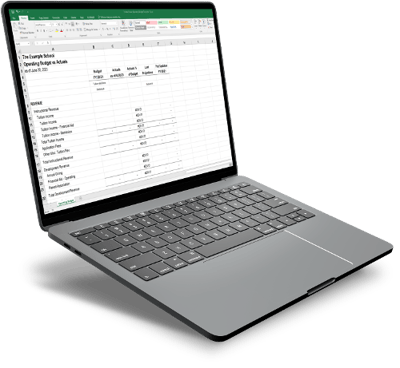The budgeting process is arguably one of the most important tools for creating a road map to your private school’s success. Planning and monitoring your budget can help you identify wasteful expenditures, adapt to financial changes, and achieve your school’s financial goals.
Before You Start Your Budget
The budgeting process shouldn’t be limited to your school’s financial personnel; it should also include the board and senior leadership.
A timeline for the process should be established, leaving adequate time for budget research, review and feedback.
Finally, be prepared to document everything along the way. Among other things, good documentation will ensure that each participant understands his or her responsibilities and deadlines.
Let’s get started. Following is a list of three of the most basic but important budgeting best practices you can implement for your private school.
1. Practice Income-Based Budgeting
It’s important to budget for income first and base income goals on conservative, reliable and realistic expectations. Of course, in order to accurately budget for income, you’ll need input and cooperation from all departments.
Budgeting tuition income is definitely a chore, especially if enrollment numbers fluctuate widely from year to year. It is best to rely on past history, adjusted for current economic impact, and always be a bit conservative on enrollment expectations. If you budget tuition income conservatively, it should create a natural cushion in the overall budget if enrollment exceeds expectations. By budgeting tuition income this way, you’ll have a realistic target of the amount needed from the fundraising side of the income equation in your budget. This might be revenue raised through events or through contributions.
Be sure to understand the impact and timing of restricted contributions and their releases, as the timing might not impact the current year’s budget. We do not recommend including income projection “cushions” simply to balance the budget, as this can set up your school for a budget deficit if the projected income fails to hit its target.
Establishing your income first will lay the groundwork for setting organizational and programmatic expenses for your school.
2. Tie Your Budget to Your School’s Mission and Goals
Revenue and expenses should be tied to your school’s mission and goals. Salaries for instructors, one of the largest expenditures, are variable based on the student / teacher ratio of your school’s teaching model. If you tie this expense to the enrollment targets you should have your largest variable expense under control. When you review the other expenses based on your mission and goals, you will likely be able to identify expenses that can be reduced or eliminated, potentially saving your school money. These savings can then be applied to other purposes that are more closely tied to your school’s mission.
The same approach should be taken when it comes to revenue. Are you, for example, putting a lot of time and energy into applying for a grant just because it might be available, even though it might not support your school’s mission?
3. Be Detailed, Detailed and More Detailed
The more detailed your budget is, the better your school’s leaders — some of whom might not have a financial background — will be able to see sources of revenue and expenditures. A detailed budget helps position your school’s leaders to make informed decisions.
Many budgets are approved by board and finance committee members who might not have knowledge about all of the school’s departments and programs. This can make it challenging for them to fully understand the budget that’s presented to them for approval.
When assumptions (expected income or expected expenses) are included in the budget, it can be even more difficult for non-financial people to understand. A detailed explanation of each assumption will allow your board members to fully understand and determine if that assumption is necessary and accurate.
A Final Word on Budgets
Remember, a budget is not just a tool to be used at the beginning of your school’s new year. Budgets should be compared to actual numbers on a regular basis to determine in real time how your school is performing.
As much as you should try to stick to your budget, be prepared for potential changes. Unexpected circumstances that occur during the year might require deviations from the original budget. When variations occur or changes are made, be sure to clearly communicate to everyone who will be impacted, and document the change, including what brought it about and when, how and why the variance occurred or the change was made.
Need Help?
Contact us online or call 800.899.4623.


